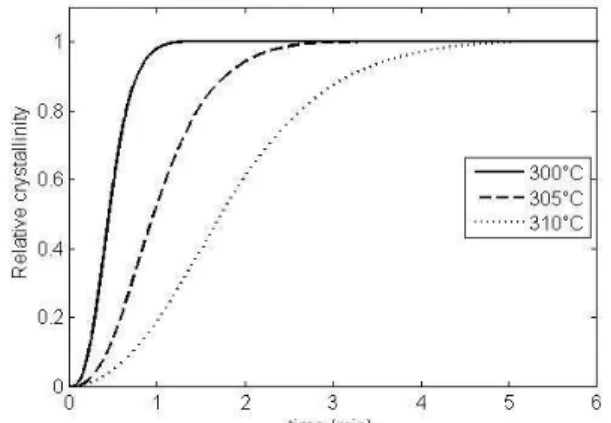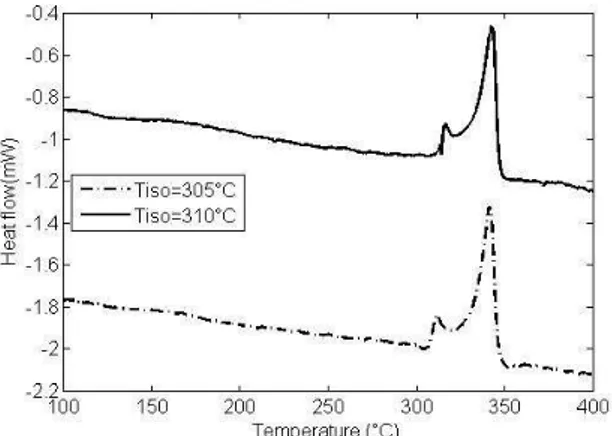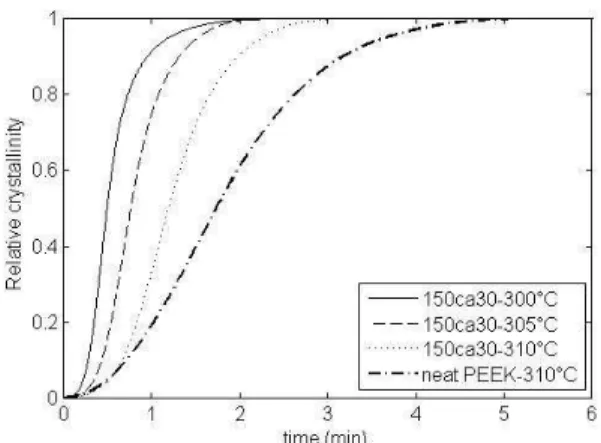HAL Id: hal-01760266
https://hal.archives-ouvertes.fr/hal-01760266
Submitted on 23 Feb 2021HAL is a multi-disciplinary open access archive for the deposit and dissemination of sci-entific research documents, whether they are pub-lished or not. The documents may come from teaching and research institutions in France or abroad, or from public or private research centers.
L’archive ouverte pluridisciplinaire HAL, est destinée au dépôt et à la diffusion de documents scientifiques de niveau recherche, publiés ou non, émanant des établissements d’enseignement et de recherche français ou étrangers, des laboratoires publics ou privés.
Experimental and modeling of isothermal crystallization
of peek matrix and c/peek composites with application
of parallel Avrami model
Emeline Bessard, Olivier de Almeida, Gérard Bernhart
To cite this version:
Emeline Bessard, Olivier de Almeida, Gérard Bernhart. Experimental and modeling of isothermal crystallization of peek matrix and c/peek composites with application of parallel Avrami model. ECCM 15 -15th European Conference on Composite Materials, Jun 2012, Venice, Italy. 7 p. �hal-01760266�
Experimental and Modeling of Isothermal crystallization of PEEK matrix
and C/PEEK composites with application of parallel Avrami Model
E. Bessard1, O. De Almeida1, G. Bernhart1 1
Université de Toulouse; ICA (Institut Clément Ader); Mines Albi Campus Jarlard, F-81013 Albi cedex 09
Keywords: PEEK, crystallization, reinforced PEEK, modeling
Abstract
Isothermal crystallization kinetics of neat PEEK (Poly(Ether-EtherKetone)) and carbon fibers reinforced PEEK (30% in mass) were studied and modeled. A differential scanning calorimeter was used to monitor heat flow during isothermal crystallization between 300°C and 310°C. PEEK thermoplastic polymer exhibits a particular crystallization that induces a double melting peak after isothermal crystallization that is described by a model that features two competing nucleation and growth mechanisms. Concerning neat PEEK and reinforced PEEK respectively, the first mechanism is a primary crystallization with Avrami’s coefficient of 2.1 (resp.3.2), the second is interlamellar crystallization with Avrami’s coefficient of 1.7 (resp. 2.7). Kinetics parameters are identified, and confirm the influence of fibers on crystallization kinetic.
1 Introduction
General tend in aeronautical industry is to move toward more eco-efficient and REACH compatible materials and processes. One of the main topic concerns the composite material technology, where the classical thermoset based autoclave manufacturing is progressively replaced by out of autoclave processes and thermoplastic based materials. As a matter of fact this later class of materials has no requirements for low temperature conservation of raw materials and allows rapid manufacturing processes.
Among the different thermoplastics, Poly-Ether-EtherKetone (PEEK) corresponds to the one that allows to get the best mechanical properties. Nevertheless such high properties can only be obtained if the level of crystallinity is high enough (typically more than 35% in mass), and in particular if crystallization occurs at high temperature (isothermal conditions) or at low cooling rates. In such conditions the material exhibits a double melting peak, where the main one corresponds to the classical theory of nucleation and subsequent crystal growth, very well described by the classical macroscopic models [1, 2]. If secondary melting peak origin is still discussed, most of the authors agree that it may correspond to a secondary crystalline phase [3-6].
It is therefore of prime importance to develop models able to predict this complex crystallinity rate of PEEK for material process optimisation purposes. Velisaris and Seferis [7] first proposed a model for isothermal crystallization of PEEK combining two Avrami models in order to take into account two competing crystallization processes for neat PEEK.
This paper investigates the effect of adding carbon fibres on the crystallization behaviour of neat PEEK and their influence on the parameters of a specific crystallisation model, based on generalized Avrami form [8] during isothermal crystallization conditions.
2 Materials and testing methods
The neat material under investigation is a (Poly-Ether-Ether-Ketone) PEEK provided by Victrex as a powder with the reference 151G. The reinforced PEEK is a 150Ca30 compound, supplied by Victrex to with 151G PEEK reference and 30% of short carbon fibers. The crystallization kinetics were studied by Differential Scanning Calorimetry (DSC) with a Perkin-Elmer 8000 equipment. The DSC sealed caps were prepared with 1.5 to 2 mg of PEEK powder and, in order to start the cooling from a nuclei-free melt, the samples were systematically heated from room temperature to 400°C and held for 5 minutes in the molten state.
After quickly cooling the sample at 200°C.min-1, samples are kept at Tiso for 15 min and
cooled again quickly to room temperature. All the crystallized samples were subjected to a heating ramp of 10°C.min-1 from room temperature to 400°C in order to determine the mass fraction crystallinity in considering a reference enthalpy of fusion of 130J.g-1 [8]. The transformation rate was assessed from the crystallization heat flux by using the partial area method.
2 Isothermal crystallization results
2.1 Neat PEEK isothermal crystallization
Five isothermal temperatures were investigated between 300°C and 310°C, considering 3 samples per temperature. The relative mass crystallinity is plotted as a function of time in Figure 1 for 3 different temperatures. It can be seen that PEEK crystallization is a continuous process, and if its general sigmoidal shape is characteristic of an classical nucleation and growth process, its non symmetry confirms the unusual crystallization behaviour of PEEK. Crystallization duration depends on testing temperature: for an equivalent transformation rate, the lower the temperature, the higher the crystallization kinetic is, i.e. if crystallization at 310°C occurs within 6 minutes this duration drops to less than 1 minute at 300°C.
Figure 1. Isothermal crystallization kinetics for neat PEEK
Figure 2 illustrates the endothermic thermograms of polymer melting measured after isothermal crystallization at, 305 and 310°C : the PEEK fusion systematically displays a double peak already reported in the literature [3, 6, 9, 10]. The main melting peak temperature is 343°C whatever isothermal temperature investigated during the cooling stage. It corresponds to the fusion of the orthorombic crystalline phase of PEEK and it is assumed to be the main melting temperature [7, 11]. The maximum temperature of the secondary melting
peak, appears at lower temperature. This peak, is consistently 6 to 7°C above the temperature of the isothermal crystallization step. For example, an isothermal crystallization at 310°C induces a secondary melting peak at 317°C.
Figure 2. Enthalpy of fusion for neat PEEK crystallized at 305°C and 310°C
Most of the authors agree that this secondary may correspond to a crystalline phase, therefore, this peak must be taken into account when calculating the total degree of crystallinity.
T isotherm (°C) ∆H (J.g -1 ) Standard Deviation Xm (wt%) 300 47.9 1.6 36.6 302 48.8 2.6 37.5 305 47.1 0.3 36.2 308 47.6 0.8 36.6 310 49.2 0.7 37.8
Table 1. Enthalpies of fusion and crystalline mass fraction for different temperatures
Table 1 summarizes the enthalpy of fusion and the resulting degree of crystallinity obtained for the five different test conditions. It can be seen that, taking into account this double peak insures a large degree of crystallinity, above 34%wt for all investigated test conditions, Moreover, the estimated Standard Deviation of the three different tests is low and confirms the methodology used.
2.2 Carbon fiber reinforced PEEK isothermal crystallization
Similarly five isothermal temperatures were investigated between 300°C and 310°C. In figure 3, the relative mass crystallinity is plotted as a function of time for three different temperatures, and is compared to the crystallization kinetic of neat PEEK at 310°C. As for neat PEEK the sigmoidal shape is characteristic of the crystallization of homopolymer with nucleation and growth process. The time needed for crystallization depends on testing temperature and is less than 4 min. Comparing reinforced PEEK crystallization, it appears that fibers increase the kinetics of PEEK crystallization, as it can be seen on the figure 3 at 310°C
Figure 3. Isothermal crystallisation kinetic of reinforced PEEK and neat PEEK
Figure 4 illustrates the endothermic thermogram of reinforced PEEK measured after two isothermal crystallization step 300°C and 310°C. As for neat PEEK a double melting peak appears, this second melting peak still appears at lower temperature and is consistently 6 to 7°C above the temperature of the isothermal crystallization step (resp. 307°C for an isotherm at 300°C).
Figure 4. Enthalpy of fusion for reinforced PEEK crystallized at 300°C and 310°C
Table 2 shows the enthalpies of fusion and the mass crystallinity obtained after isothermal crystallization at 300°C, 302°C, 305°C, 308°C and 310°C. Final crystallinity rates always exceed 33% , the maximum is obtained for temperatures below 305°C. Despite a high crystallinity, a difference of 2-3% on final mass crystallinity could be noticed between neat and reinforced PEEK. So, the introduction of 30% carbon fibres has an influence on crystallization kinetics and on the final mass crystallinity.
T isotherm (°C) ∆H (J.g -1 ) Xm (wt%) 300 33.5 36.8 302 32.3 35.5 305 32.4 35.6 308 29.8 33.7 310 31.3 34.4
3 Kinetic modeling and identification
3.1 Kinetic model description
The isothermal crystallization kinetics are usually studied using Avrami’s law (Eq. 1) where α(t) is the fraction of crystal transformed at time t during crystallization, X(t) is the fraction of crystallization at time t and X(∝) is the volume crystalline fraction for infinite time at temperature T [12]. Applied to polymers, the exponent n (Avrami exponent) contains some information on the type of nucleation while K characterizes the crystallization growth rate (s
-1
) and depends on the isothermal testing temperature.
( )
=( )
= −(
− ∗)
∞ 1 exp ( ) n X t t K t X α (1)In order to model isothermal and anisothermal polymer crystallization kinetics a model based on a generalized Avrami form (Equation. (2))[13] was proposed in a previous work [8]. This form allows the expression of a time independent differential evolution equation as seen in equation (3).
( )
=( )
= −(
−(
∗)
)
∞ 1 exp ( ) n X t t t X α K (2) ɺ α= 1−(
α( )
t)
∗ n ∗ K ∗ ln 1 1−α( )
t n−1 n (3)Nevertheless, application of the classical Avrami’s model to PEEK don’t allow a good representation of crystallization kinetic, in particular for isothermal condition [7, 8, 11, 12]. In order to take into account the contribution of the two complementary mechanisms the total crystallization rate was modeled with Equation 4 where i=1 (resp. i=2) corresponds to main (resp. minor) crystallization mechanism [8]. Each crystallization process is associated to a weighting factor, respectively w1 and w2, with w1+w2=1.
ɺ
α
= wi * ɺα
i i =1 2∑
= wi ∗ 1−(
α
i)
∗ ni ∗ Ki ∗ln 1 1−α
i ni−1 ni i =1 2∑
(4)3.2 Neat PEEK and carbon fiber reinforced PEEK isothermal model parameters identification
Crystallization model parameters identification is preformed with a numerical optimization procedure developed in Matlab®; it compares isothermal DSC results with the numerical integration of Equation 4 using Runge-Kutta method. During the optimization only upper and lower bounds were set for w1 (respectively 1 and 0,5), and four other parameters (n1, n2, K1
and K2) were considered free. Table 3 summarizes the optimization results obtained for the
different materials at three temperatures.
For each material configuration the exponents n1 and n2 are found constant, thus not
influenced by temperature. Concerning neat PEEK, the Avrami exponents for the first and the second mechanism are respectively 2.1 and 1.7. The n exponent characterizes thecrystallization type (nucleation and growth), and according to the results, carbon fibers have a strong influence on crystallization indeed Avrami exponent evolve toward 3.2 and 2.7.
Neat PEEK 150ca30 Neat PEEK 150ca30 Neat PEEK 150ca30 Temperature (°C) 300 305 310 K1 (T) 3.1.10-2 3.1.10-2 1.2.10-2 2.1.10-2 4.3.10-3 1.3.10-2 K2(T) 1.1.10 -2 1.5.10-2 7.5.10-3 1.1.10-2 3.2.10-3 8.10-3 n1 2.1 3.2 2.1 3.2 2.1 3.1 n2 1.7 2.7 1.7 2.7 1.7 2.7 w1 0.94 0.75 0.65 0.74 0.63 0.78
Table 3. Neat PEEK and reinforced PEEK (150ca30), kinetic model parameters for three temperatures
For neat PEEK, the weight factor w1 decreases from 0.94 to 0.63 when temperature increases
from 300°C to 310°C. This evolution indicates that the main crystallization process has a strong contribution on total crystallization and also that the contribution of secondary crystallization mechanism is more important at high temperature. On the contrary for reinforced PEEK, the w1 factor seems to be constant and there is always a strong contribution
of the second mechanism.
The kinetic parameters K1 and K2 are largely influenced by temperature and presence of
carbon fibres. K1 and K2 decrease when temperature increases. The identified kinetic
parameters for reinforced PEEK are higher than those obtained for neat PEEK, that confirms the shorter crystallization time of reinforced PEEK. Correlation between experiment and model is always very good and is illustrated on Figure 5 for a temperature of 310°C. The contribution of the two crystallisation mechanisms as predicted with the model is also reported on the figure and gives confirmation that even if primary crystallisation starts first, the second mechanism has a contribution higher than 20% to the total crystallized mass fraction at this temperature.
Figure 5. Reinforced PEEK Isothermal crystallization kinetic modelling at 305°C
4 Conclusion
Isothermal DSC measurements for neat and reinforced PEEK show that the introduction of fibers leads to modification of crystallization kinetics. With 30% of carbon fibers, the crystallization duration is less than for the neat matrix. In both cases, isothermal crystallization induces the occurrence of a second melting peak that characterizes two parallel crystallization mechanisms.
The use of a differential form of Avrami equation and considering that PEEK crystallization is induced by two complementary mechanisms, allows to model with a good accuracy isothermal crystallization. The identification of kinetics parameters for neat PEEK and
reinforced PEEK reveals the influence of fibers on crystallization kinetics. K1 and K2 kinetic
parameters are more important for reinforced PEEK in accordance with experimental results The values of Avrami exponents depend also on the material. So the n1 were respectively 2.1
and 3.2 for neat and reinforced PEEK, suggesting an heterogeneous nucleation with three dimensional growth due to presence of fibers. The n2 values in the latter stage (and related to
mechanism two) of crystallization are 1.7 and 2.7 and are representative of an interface controlled growth.
References
[1] Supaphol P., Sprueil J.E. Application if the Avrami, Tobin, Malkin, and Urbanovici-Segal makrokinetic models to isothermal crystallization of syndiotactic polypropylene.
Thermochimica Acta, 370, pp. 37-48 (2001).
[2] Long Y., R.A. Shanks R.A., Kinetics od polymer crystallisation. Prog. Polym. Sci., 20, pp. 651-701(1995).
[3] Verma R.K., Velikov V. SAXS studies of lamellar level morphological changes during crystallization and melting in PEEK. Polymer,. 37(24), pp. 5357 - 5365(1996).
[4] Bessard E., De Almeida O., Bernhart G. Melt state behaviour of PEEK and processing
window interpretation for fast compression moulding process in AMPT 2010, Int. Conf. on Advances in Materials and Processing Technologies, Paris, France, (2010).
[5] Boyard N., Sobokta V., Cinétique de cristallisation des polymères semi-cristallins in Mise en œuvre des composites à matrice thermoplastique, Nantes, France (2010).
[6] Latimmer M.P., Hobbs J.K. On the origin of the multiple endotherms in PEEK. Polymer, 33, pp. 3971-3973(1992).
[7] Velisaris, C., Seferis J. Crystallization Kinetics of Polyehteretherketone (PEEK) Matrices.
Polym. Eng. Sci., 26, p. 1574-1581(1986).
[8] Tan S. Crystallization kinetics of poly(ether ether ketone) (PEEK) from its metastable melt. Polymer, 40(5), pp. 1223 - 1231(1999).
[9] Chao S.-C., Chen M. Isothermal Crystallization and melting Behavior of Short Carbon Fiber Reinforced Poly (ether ether ketone) Composites. Journal of Polymer Research, 5(4), pp. 221 - 226(1998).
[10]Wei C.-L., Chen M. Temperature modulated DSC and DSC studies on the origin of double peaks in PEEK. Polymer, 44, pp. 8185 - 8193(2003).
[11]Cebe P., Application of the parallel Avrami Model to crystallization of Poly(Etheretherketone). Polymer Engineering and Science, 28, pp. 1192-1197(1988). [12]Avrami J. J. Chem.Phys., 7, p. 1103(1939).
[13]Bessard E., O. De Almeida, Bernhart G. Unified isothermal and anisothermal modeling of neat PEEK crystallization. Polymer (2012).



